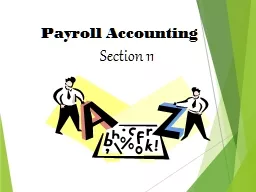

Overview Accounting Principles Account Classifications Account Balances Journal Entries Recording Payroll Transactions Accounting Periods Accruals and Reversals Balancing and Reconciliations ID: 781226
Download The PPT/PDF document "Payroll Accounting Section 11" is the property of its rightful owner. Permission is granted to download and print the materials on this web site for personal, non-commercial use only, and to display it on your personal computer provided you do not modify the materials and that you retain all copyright notices contained in the materials. By downloading content from our website, you accept the terms of this agreement.
Slide1
Payroll Accounting Section 11
Slide2Overview
Accounting Principles
Account Classifications Account Balances Journal Entries Recording Payroll Transactions Accounting Periods Accruals and Reversals Balancing and Reconciliations Financial Statements & Audits
Slide3Accounting Principles
FASB vs. GASB
GAAP
Business Entity Concept Continuing Concern Concept Time Period Concept Cost Principle Objectivity Principle Matching Principle Realization Principle Consistency Principle
Slide4Account Classifications
Double Entry Accounting
*always need a debit and a credit Equations:ACRONYMS
ALE:
Assets – Liabilities = Equity
REN:
Revenue – Expenses = Net Income
NICE:
Net Income – Income Distributed + Contributed Capital = Equity
[Contributed Capital + Net Income – Income Distributed = Equity]
Slide5Account Classifications
Asset Accounts
Current
Tangible or Property, Plant and EquipmentIntangible or Deferred
Slide6Account Classifications
Liability Accounts
Current
Wages payableTaxes WithheldContributions to Benefit PlansAccounts PayableLong TermNotes Payable
Slide7Account Classifications
Equity
Contributed Capital
Retained EarningsNet IncomeRevenueAmounts received for goods & services soldExpenseCost of goods and services consumed
Slide8Account Balances
Type of Account
Typical Balance
Debit
Credit
Asset
Debit
Increase
Decrease
Liability
Credit
Decrease
Increase
Equity
Credit
Decrease
Increase
Revenue
Credit
Decrease
Increase
Expense
Debit
Increase
Decrease
Contributed Capital
Credit
Decrease
Increase
Income Distributed
Debit
Increase
Decrease
Slide9T Accounts
Payroll Checking
Debits
Credits
Wages Payable
Debits
Credits
$100.00
$100.00
Slide10Chart of Accounts
Makes distinctions between Assets, Liabilities, Expenses, and Revenues
Makes distinctions between types of Assets, Liabilities, Expenses, and Revenues Uses cost centers or department codes
Slide11Types of Journal Entries
Compound Entries
General Ledger Subsidiary Ledger Accounts Payable Accounts Receivable PPE (Fixed Assets)
Slide12Double Entry Cash Journal Entry
A wage payment of $100 would appear
in a journal entry as follows:
Debit CreditSalary Expense $100Cash $100
Slide13Compound EntryCash Journal Entry
A payroll check was issued and recorded to the general ledger.
Gross wages were $500. Taxes were withheld as follows: $75 for FIT, $35 for Soc Sec, $7.25 for Medicare.
Debit CreditSalary Expense $500 Federal taxes withheld $75.00Social security taxes withheld $21.00Medicare taxes withheld $7.25Cash $396.75
Slide14Accrual TransactionsSimple Journal Entry
Record Wages of $6340 due to employee
but not yet paid
Debit CreditWages Expense $6340Wages Payable $6340
Slide15Accrual TransactionsCompound Journal Entry
Salary of $6340 and Taxes of $485 Accrued,
but not yet paid
Debit CreditWages Expense $6340Payroll Tax Expense 485Wages Payable $6340Payroll Taxes Payable 485
Slide16Accounting Periods
Monthly, Quarterly or Yearly
Fiscal Year vs. Calendar Year
Employment Tax Returns / Employee or Payee Information Statements
Slide17Accrual & Reversing Entries
Accruals at end of accounting period
Reversal of Accruals
Reversal of Errors
Slide18Accrual Journal Entries
An accrual entry of $1000 was made in 2013 for a bonus to be paid in Jan. 2014. The bonus was paid in 2014 and Soc Sec & Medicare taxes were paid by the employer of $76.50. Federal, SS & MC taxes were withheld from the check of $326.50. What is the journal entry to record the accrual in 2013 and what is the entry to record the payment of the bonus in 2014?
Debit CreditWages Expense $1000PR Taxes Expense $ 76.50 Wages Payable $1000PR Taxes Payable $ 76.50 Debit CreditWages Payable $1000PR Taxes Withheld $326.50
Cash $673.50
Slide19Debit or Credit Quiz
Increase to Expenses
Increase to Liability
Decrease to AssetsDecrease to RevenueIncrease to CapitalDecrease to ExpensesIncrease to AssetsDebitCredit
Credit
Debit
Credit
Credit
Debit
Slide20Balancing and Reconciliation
Periodic Balancing
What? Check against the payroll register Verify checks issued by A/P Verify the end of the month balanceWhen? Every payroll period Before filing tax returns Before sending out W-2’s or 1099’s
Bank Accounts – dual control
Slide21Financial Statements
Balance Sheet
Income Statement Statement of Cash Flows Trial Balance Statement of Retained Earnings Notes to Financial Statements Audited Financial Statements
Slide22Budgets and Variances
Budget vs. Actual format
Variances
Favorable Variance Unfavorable Variance
Slide23Budgets and Variances Quiz Salary expense for the month of January was budgeted at $500. The actual expense incurred was $300. Is the variance favorable or unfavorable?
Answer: Favorable by $200
Slide24Questions ?
Slide25Overview Internal Controls
Sarbanes – Oxley Act
Check Fraud
Check 21 Accounting Interfaces with Payroll Terminology
Slide26Internal Controls
Blank Checks
Computer System Edits Internal Auditor Negative Pay deductions Payroll Bank Account Payroll Distribution Phantom Employees Rotation of job duties
Segregation of job duties
Time Reporting
Slide27Sarbanes-Oxley Act
Requires public companies to have a framework for identifying, documenting, and evaluating their internal controls over financial reporting.
Provides a logical way to analyze a company’s control system. Prohibits a public accounting firm from providing both external auditing and most non-auditing services to the same client and requires audit partners to rotate every 5 years.
Slide28Check Fraud
Group 1 security features
Group 2 security features
Group 3 security featuresCheck 21 Substitute checks used in clearing process Impact on payroll
Slide29Questions ?